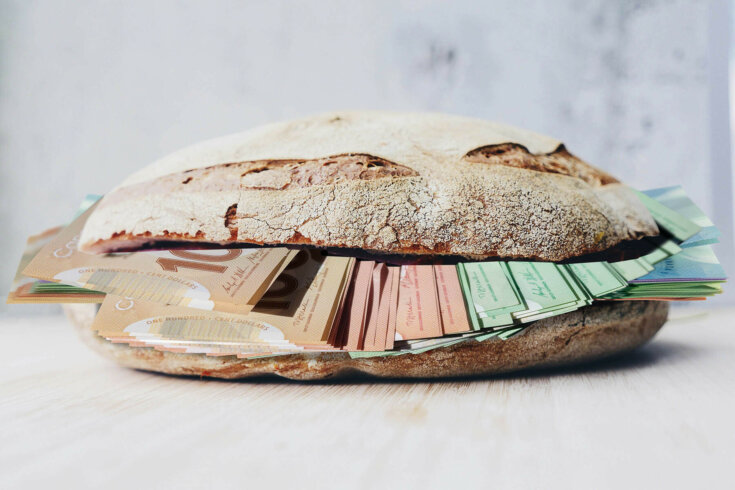Let me tell you about the sandwich I ate for lunch: a mouth-watering, foot-long torpedo of teriyaki chicken on multigrain bread, beautifully crafted by a true artist. The price, however, was enough to induce indigestion: $21.36 after tax and a 15 percent tip.
Over the past couple of years, some version of this observation has become commonplace in group chats and around dinner tables: everything is too damned expensive. A friend from Alberta recently texted in disbelief when his coffee rang in at $8, a price he once paid for an entire lunch. In May, CTV reported that the price of a McDonald’s Big Mac value meal had risen to $17.59, and that fast food prices had risen 33 percent since 2019.
It’s not just fast food. The cost of everything has been trending upward, from extra virgin olive oil (which more than doubled in price over the past three years) to cars (a new set of wheels will set you back an average of $67,817, up almost 20 percent since 2023). Canada’s Food Price Report in 2023 warned that a family of four could expect to spend $16,288.41 per year on groceries, an annual increase of about $1,065.60. The 2024 edition of the report predicted yet another jump, of $701.79.
On it goes. Gasoline has surged more than 37 percent since 2019. Rent has shot up by about 10 percent over the past year alone. Mortgages have been unsustainable for many homeowners, while home prices continue their seemingly inexorable climb, especially in large urban centres. The Barenaked Ladies once promised to “buy you a house” if they had “$1,000,000.” Good luck with that: the median sale price for a single detached home sailed past that marker long ago, at least in Toronto. It’s now $1.3 million.
Newcomers to Canada are taking note. “I was here in 2018 for a working holiday, loved it. Have moved back now and WOW it’s soooo expensive,” a recent transplant noted on a “Moving to Canada” Reddit thread. “Advice to people moving, bring more money than you expect you’ll need!!!!”
Grumbling about rising costs is a universal fact of life. Perhaps you, too, grew up with grandparents fond of recalling how, in the olden days, you could get a jug of milk for “two bits.” (Just what a “bit” was, I never knew.) But today’s dissatisfaction feels new. The anger is taking a political shape. Simmering frustrations are erupting into boycotts, era-defining political slogans, and a generalized “affordability crisis” that may deliver the Conservatives and Pierre Poilievre a decisive electoral victory.
What’s more, all of this appears to be happening at a time in which specific financial indicators, such as our current interest rate, labour market, and economic growth, are “outperforming expectations,” which is, in a way, doubly alarming. Whether the federal government can alleviate the situation may now be beside the point as public perception takes on a life of its own. We may be living through a new age of consumer rage, and its consequences are anything but certain.
Canada’s current economic woes are the product of multiple causes. Early in the lockdown phase of the COVID-19 pandemic, supply-chain issues dominated the news, often accompanied by the familiar image of empty toilet-paper aisles. Household spending on recreational services, clothes, and other discretionary items dropped substantially. Then unemployment spiked when the service and entertainment industries shut down nearly overnight, prompting a surge in government spending through the Canada Emergency Response Benefit and other subsidies to support those out of work.
Meanwhile, lots of people retired, moved, or quit—“quietly” or not. As restrictions began to lift, some workers were reluctant to get back to the pre-pandemic grind. An extremely tight labour market in the immediate post-pandemic moment drove up structural costs for employers, with labour costs 13 percent above their pre-pandemic baseline, and such costs were passed along to the consumer. On top of this, two years of post-pandemic “revenge spending” seemed to indicate that the market could, perhaps unrealistically, sustain higher prices. That party has ended.
At the same time, high levels of government spending drove up inflation. Between 2010 and 2020, Canada’s inflation rate hovered at around 1.5 percent; it was 0.72 percent in 2020. By 2022, it was 6.8 percent and almost 4 percent in 2023. The Bank of Canada responded with aggressive rate hikes, adding to consumer misery with higher credit card interest and climbing variable mortgage rates. Overall, the rate hikes seem to have worked. In September, the bank eased the key interest rate twenty-five basis points, to 4.25. Still, it’s not that prices will ever drop to their pre-pandemic levels. Rather, the bank’s strategy has succeeded in only slowing down future increases in relation to present prices, which are mostly locked in.
We thus find ourselves in a contradictory moment, where inflation is trending down but consumer confidence has failed to rebound. There’s the economy, and then there’s how people feel about the economy, and those feelings matter. That’s why the Bank of Canada tracks consumer sentiment in its quarterly Canadian Survey of Consumer Expectations, which polls 2,000 households on their sense of inflation, employment prospects, and household finances.
According to the most recent survey, Canadians’ “perceptions of inflation continue to be higher than the actual consumer price index inflation.” Respondents attribute the inflation to high government spending and elevated housing costs and don’t expect any short-term solutions. We remain pessimistic about our own finances and report “various indicators of perceived financial stress,” including the probability of missing debt payments. We believe the labour market is getting worse, with people reporting a greater likelihood of job loss. “We talked a lot about labour shortages during the pandemic, but it’s another reality now,” one respondent said. “There are a lot of job cuts and it’s increasingly hard to find a job.”
When asked about the expectations for their financial situation over the next year, Canadians anticipate slower income growth and weaker economic conditions overall. We believe, in short, that our financial life will be worse a year from now than it is today.
When it lumbers onto the field of politics, consumer dissatisfaction is a strange and fickle beast. Most of the time, it feels more inchoate and less organized than other forms of political discontent, because its effects are distributed throughout the economic field. Consumers care about different things, and nobody cares enough about any one thing. If the price of peanut butter gets exorbitant, even the most inveterate spoon eaters of that divine substance (of whom I am one) will never disrupt an award ceremony or opening-night film screening. We’ll just eat less peanut butter and become sad.
But what happens when the price of everything goes up? History is replete with examples where, after a period of docility, consumers snapped. It happened in 1966, when middle-class American women in Denver, exasperated over food prices, began picketing outside grocery stores in what was sometimes called the “housewife revolt.” More recently, an estimated 140,000 protesters marched in Paris, demanding a freeze in the prices of energy, essential goods, and rent, as well as urgent action against the climate crisis. Indeed, over the past couple of years, perceived government inaction over inflation and unemployment has caused thousands of people to take to the streets around the globe.
While we haven’t seen spectacular street protests here in Canada, evidence suggests that consumer discontent may be curdling into something volatile. One Reddit group, r/loblawisoutofcontrol, devoted to “highlighting the ridiculous cost of living in Canada,” now boasts nearly 100,000 members. In May, the group earned national media attention by calling for a month-long boycott of Loblaw-affiliated stores; a subsequent poll found that 18 percent of Canadian households actively participated. The boycott’s impact on the company’s bottom line may have been marginal, but the group’s energy seems undiminished. Organizers have since announced that the boycott has been extended indefinitely.
Meanwhile, the federal Conservatives, under Pierre Poilievre, have firmly ensconced the affordability crisis at the centre of their pitch to Canadians. Last fall, Poilievre argued on the floor of the House of Commons that “you can buy a castle in France for a lower cost than a middle-class home in Ontario,” pressing the government to “reverse their inflationary deficits and reverse their tax hikes so that Canadians can eat, heat, and house themselves.” His signature slogan, “Axe the tax,” pegged to the Liberal government’s levy on consumer carbon, has been interpreted more broadly as “everything is too expensive.” (The slogan itself may have been borrowed from a 2008 New Democratic Party campaign in British Columbia.)
Critics have cast significant doubt on whether Poilievre’s proposed housing interventions will have any tangible impact. Yet Conservative strategists are convinced that affordability will deliver a Poilievre win, citing polls showing that unionized workers—even in the public sector—now back the Conservatives.
As Poilievre continues to hammer away at his core affordability messages, it is of course possible that the very terms in which consumer sentiment is measured will become hopelessly politicized. As Rogé Karma wrote in The Atlantic in February, consumer sentiment itself may become “a more performative metric than it used to be—a statement about who you are rather than how you really feel.” In our context, as “affordability” takes on an increasingly Conservative tinge, progressive sentiment may shift in the opposite direction.
That’s probably wishful thinking for the Liberals, at least in the immediate term. While big-ticket items which we purchase only rarely, such as houses and cars, are most impacted by inflation, it is the small, daily things—the $8 coffee, the $20 sandwich—that keep consumer rage simmering, even if it is on the back burner. We will, of course, get used to these prices. One day, we may even wax nostalgic about those cheap $20 Subway sandwiches. But not before the next election.
The Trudeau epoch may be brought down by a million trivial, infuriating expenses, which might seem like a desperately unfair shake for the prime minister. Inflation has been bad in Canada, but it’s been bad everywhere. In 2022, global inflation rose at its highest rate in forty years, according to the International Monetary Fund. Food prices are similarly influenced by global factors, including supply and shipping disruptions stemming from Russia’s invasion of Ukraine. Surely, we can’t pin all this on one person.
But Trudeau wears some of the blame. The ridiculous price of rent stems from the fact that the national vacancy rate has plummeted to 1.5 percent; it was twice that in 2020 and 2021. Rent growth, which averaged 2.8 percent between 1990 and 2022, ballooned to 8 percent between October 2022 and October 2023, far surpassing both inflation and wage growth and contributing to the affordability crisis.
According to the Canada Mortgage and Housing Corporation, the increased rental demand is driven by a “surge” in immigration and post-secondary students. For example, net international migration to BC grew by 56 percent between 2022 and 2023. Over roughly the same period, the national population grew by 3.3 percent, the highest rate in six decades, according to Royal Bank of Canada—numbers which reflect the government’s raised immigration targets. Rising mortgage rates are keeping more people in the rental market, preventing them from moving into starter homes, pushing up rental prices overall.
And while Russia’s invasion of Ukraine kicked up food prices in 2022, that alibi no longer works, since the Food and Agriculture Organization of the United Nations announced in January that global food prices dropped to their lowest point in three years.
Organizers of the recent boycott may claim that “Loblaws is out of control,” but it is really we, Canadian consumers, who are out of control. It’s not a nice feeling. We look at our mortgages, rent, the cost of food and conclude: this is unsustainable. Having lived through some tough economic times—times made tougher by our government’s policy decisions—Canadians will, at the next available opportunity, reward the party that promises to return a semblance of control.
While the opposition will continue to blame Trudeau for everything, voters would be well advised to focus on the policy levers over which we do have control, such as immigration rates or cracking down on the grocery industry’s near-monopolistic reach. But we should also regard, with skepticism, those who promise to control things they can’t. We may be getting hosed at the supermarket, but that’s no reason why our politicians, too, should take us for a ride.





